The different types of cat litter available in the market include clay litter, clumping litter, silica gel litter, recycled paper litter, pine litter, and natural litter.
Each type has its benefits and drawbacks, so it’s important to choose one that suits your cat’s preferences and your lifestyle.
Selecting the right cat litter for your feline friend is a bit like choosing a favorite cereal—it’s all about pairing the right features with specific tastes and needs.
With a variety of options on the market, from traditional clumping clay to biodegradable alternatives, how do you sift through the choices to find the perfect match for both you and your cat? (1)
The key is understanding the role that litter plays not just in odor control and maintenance, but also in your cat’s health and the environment.
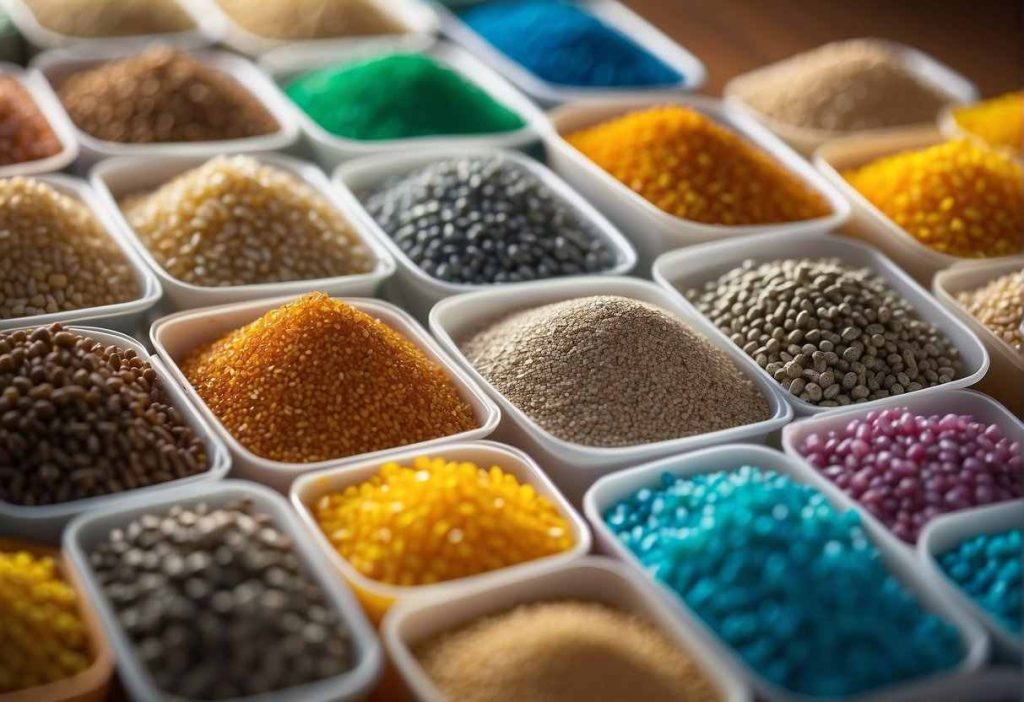
If you’re a first-time cat owner, or even if you’re contemplating a switch in your current litter setup, you’ll want to weigh factors like absorbency, how well it masks odors, the amount of dust it produces, and how comfortable it is for your cat’s paws.
Environmental impact and the ease of cleanup are also important considerations.
While clumping clay litter is a popular choice due to its convenience and efficacy in odor control, some owners are drawn to natural litters made from materials like recycled paper or pine, which may be better for the planet and more suitable for sensitive cats.
Key Takeaways
- Choosing the right cat litter involves balancing factors such as odor control, absorbency, and your cat’s comfort.
- Environmental considerations and ease of cleanup are increasingly important to cat owners.
- Clumping clay litter is popular, but natural and biodegradable options are gaining traction among eco-conscious consumers.
Types of Cat Litter Explained
Clay Litter
Clumping Clay Litter So you love convenience, right? Clumping clay litter is your go-to for easy scooping, as it forms solid clumps when your kitty does their business. (2)
Benefits? Quick cleanup and great odor control. Drawbacks? It’s heavier and may track more than other types.
Non-Clumping Clay Litter Budget-friendly and straightforward, non-clumping clay litter absorbs well but skips the clump.
Benefits? Gentle on the wallet. Drawbacks? Changes require dumping the whole box, and it’s not the best at odor control.
Silica Gel Litter
Silica gel litter, fancy seeing you here! Little crystal beads that absorb moisture like a pro. (3)
How it works? They suck up liquid and reduce the smell.
Best for whom? Busy cat parents who prefer less frequent changes.
Biodegradable Litters
Pine Litter A bit of nature for your feline’s nature calls.
Pros? Natural odor-fighting and eco-friendly vibes.
Cons? Some cats may turn up their noses at the texture.
Wheat Litter Have you heard? Wheat litter is both clumping and planet-hugging!
Pros? It’s flushable and compostable.
Cons? It might not fight off odors as fiercely as clay.
Corn Litter Did someone say popcorn? Just kidding, but cornlitter is another eco-friendly option.
Pros? It’s biodegradable and clumps naturally.
Cons? May attract bugs if not stored properly.
Grass Litter Grass litter is the new kid on the block, light and clump-tastic.
Pros? Amazing for clumping and is often dust-free.
Cons? It can be pricier than others.
Walnut Shell Litter Ever thought walnut shells could manage litter box calls?
Pros? Excellent clumping and odor control.
Cons? The dark color might make it hard to spot waste.
Paper Litter Recycled paper to the rescue!
Pros? Super absorbent and great for sensitive paws.
Cons? Doesn’t clump, so get ready for more frequent changes.
Tofu Litter Yes, tofu isn’t just for eating!
Pros? Flushable and gentle on paws.
Cons? Might not be the toughest warrior against odors.
With these insights, you’re now the litter guru. Go forth and choose the best for your purring pal!
Comparative Analysis of Cat Litter Types
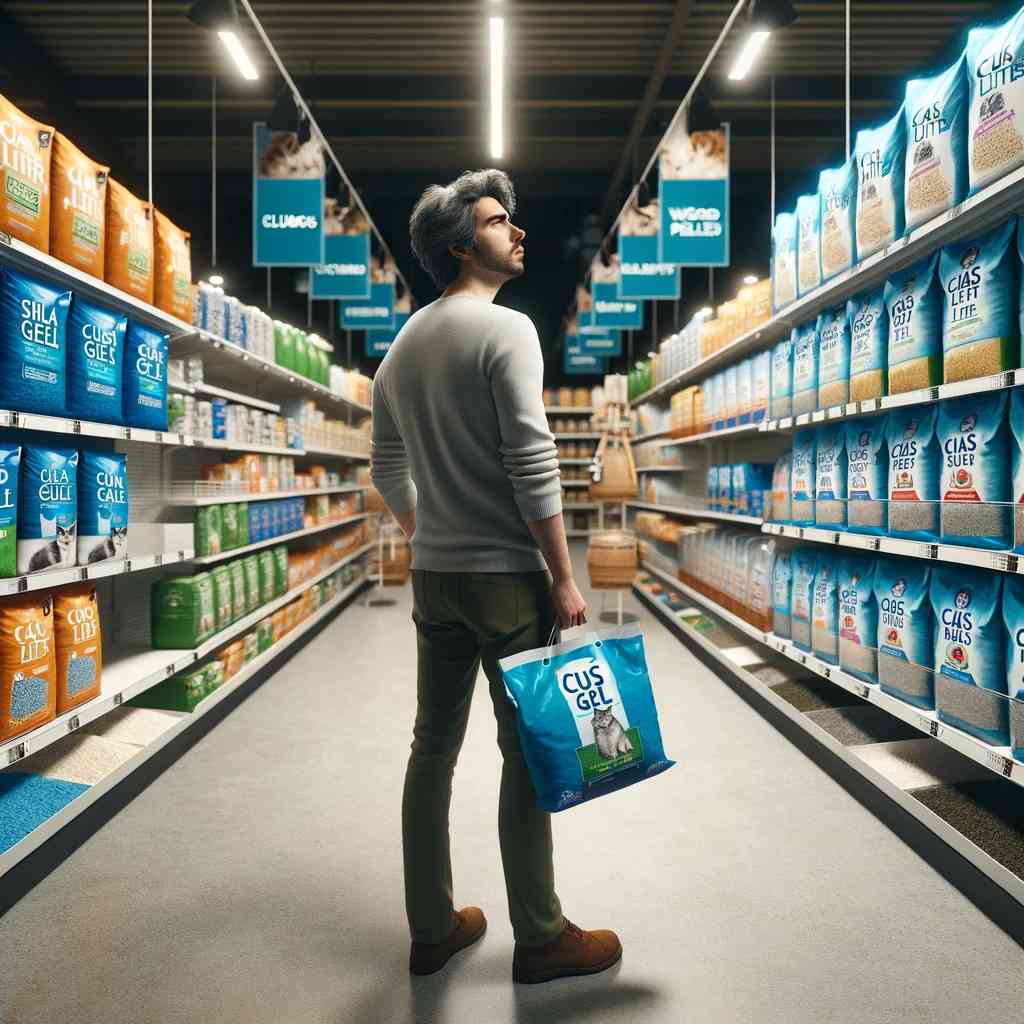
Have you ever stood in the cat litter aisle, bewildered by the choices? You’re not alone! Let’s sift through the varieties together and work out what’s best for your fuzzy friend.
Clumping Clay Cat Litter:
- Absorbency: High, which makes it easy for you to scoop.
- Odor Control: Good due to its ability to form solid clumps around waste.
- Dust Levels: This can be high, so might not be ideal for you or your cat if either of you has respiratory issues.
- Environmental Impact: Lower, as it’s not biodegradable and is mined from the earth.
- Cost: Often more affordable than other options.
Non-Clumping Clay Litter:
- Absorbency: Less than clumping, as it does not form clumps.
- Odor Control: Moderate; frequent changing is necessary.
- Dust Levels: Similar to clumping, there can be a lot of dust.
- Environmental Impact: Same as clumping clay, with the added frequency of changing impacting the environment.
- Cost: Usually cheaper than clumping clay litter.
Other Litter Types: Biodegradable options like recycled paper, wood, or corn can tick your green boxes. They’re good at controlling odor and may be dust-free, but can vary in absorbency. (4)
| Litter Type | Absorbency | Odor Control | Dust Levels | Environmental Impact | Cost |
| Clumping Clay | High | Good | High | Lower | $ |
| Non-Clumping Clay | Moderate | Moderate | High | Lower | $ |
| Biodegradable (e.g., wood, corn) | Varies | Good to High | Low to None | Higher | $$ |
Remember, your cat’s preference matters a lot too! You might need to experiment a bit before finding the “purr-fect” match.
Keep an eye on your cat’s reaction to the litter. And hey, no judgment if you get a little excited seeing your cat approve of your selection. Who knew picking the right litter could feel like a small victory?
Special Considerations in Choosing Cat Litter
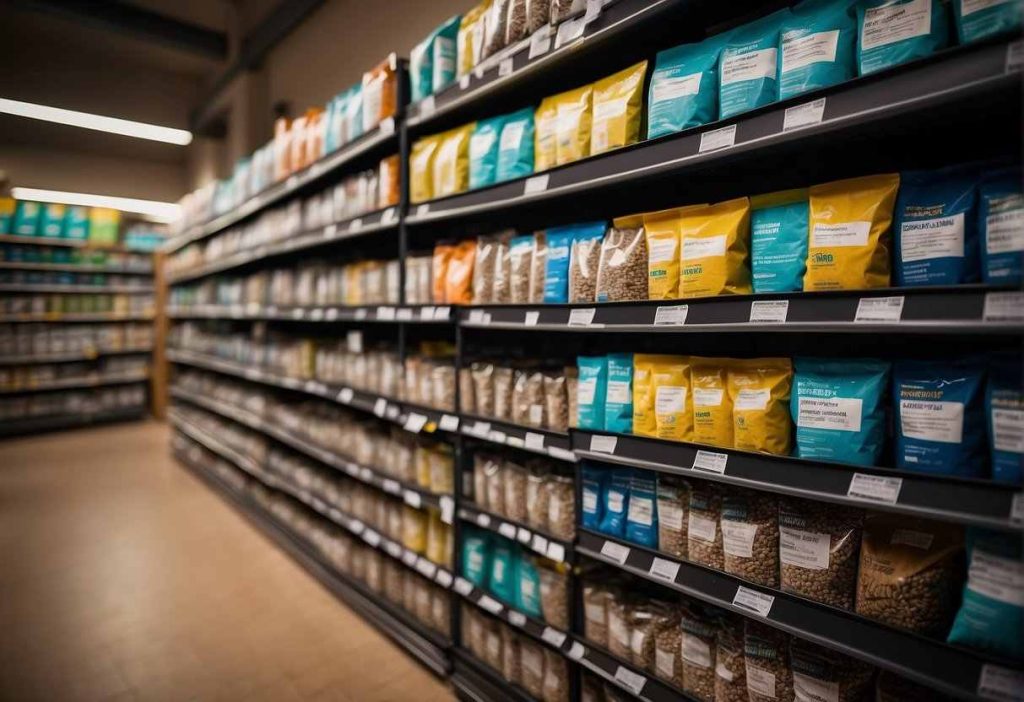
When selecting cat litter, have you ever felt like you’re navigating a minefield of choices? Well, it’s important to keep a few special considerations in mind.
For Kittens
- Soft and digestible: Young explorers often taste-test their surroundings, so opt for a non-toxic, softer litter.
- Dust-free: To keep their tiny lungs safe, choose low-dust options to minimize respiratory risks.
For Cats with Health Issues
- Hypoallergenic: If your furry friend has sensitivities, go for a hypoallergenic litter. These are less likely to cause allergic reactions.
- Low-dust: Again, for those with respiratory issues, low-dust varieties can help. Isn’t it about breathing easy?
For Multi-Cat Households
- High absorption: You’ll want a litter that’s a champ at soaking up fluids to keep that fresh home feeling.
- Odor control: With more cats, comes more… well, you know. Odor-control litters are your nose’s best friend. (5)
Environmental Impact
- Biodegradable: These types allow you to love your cat and the planet simultaneously.
- Recycled materials: Litters made from recycled paper or wood offer a pat on the back for contributing to waste reduction. (6)
Remember, the right litter can make a world of difference for you and your kitty’s daily routine, not to mention their health and happiness.
Choose wisely, and may the purrs be with you!
Health and Safety Considerations

Let’s break down what you need to know to keep your feline friend safe and healthy.
Potential Risks:
- Dust: Some cat litter can be quite dusty, which isn’t ideal for you or your cat’s respiratory system. Inhale too much, and both of you could be coughing up a storm.
- Toxic Additives: Watch out for litters with added fragrances or chemicals. They can cause allergic reactions or worse, especially in sensitive cats and the little adventurous kittens. (7)
- Clumping Agents: Sodium bentonite is a common clumping agent, and while it’s great for tidy scoop-outs, it can be harmful if ingested in large amounts by your furry pal.
Safety Tips:
- Switch slowly: Introduce new litter gradually to avoid rejection or stress.
- Low Dust Options: Opt for low-dust litters to keep those lungs as clear as the sky on a sunny day.
- Fragrance-Free: Choose unscented litter to steer clear of unnecessary chemicals.
- Biodegradable Bliss: Consider biodegradable litter like paper, wood, or corn if you want to walk the eco-friendly trail.
- Regular Cleaning: Keep that litter box squeaky clean — scoop daily and change weekly (minimum!).
Remember, your cat’s paws are curious little explorers that touch everything, including their litter.
So, let’s keep their adventure safe! With these tips in mind, you’ll be the hero your whiskered sidekick deserves, ensuring their nine lives are lived to the fullest—and healthiest!
Environmental Impact and Sustainability
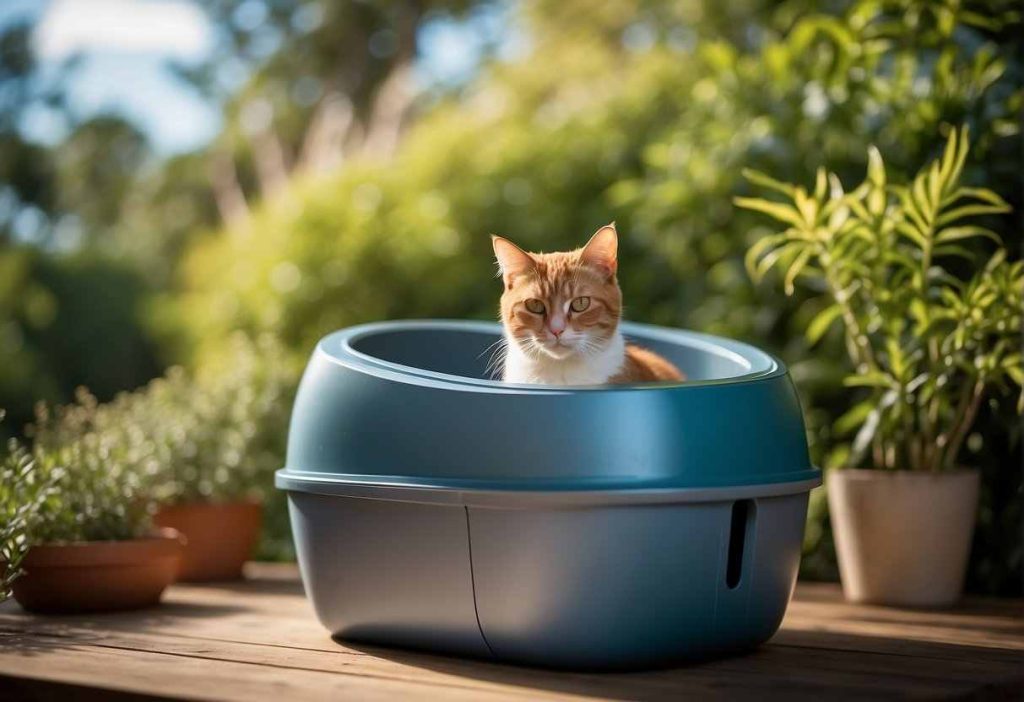
Have you ever thought about the footprint your feline friend leaves behind, specifically in their litter box? Let’s dig into which cat litter options are gentle on our planet.
Eco-Friendliness of Each Litter Type:
- Recycled Paper: Yesterday’s News, for example, turns old newspaper into a highly absorbent litter. It’s a way to reduce waste while keeping your kitty’s paws dry.
- Natural Wood: Brands like Ökocat offer a wood-based litter that is both biodegradable and renewable, ticking two boxes for sustainability.
- Walnut Shells: A product like Naturally Fresh utilizes walnut shells, a byproduct often discarded, transforming them into eco-friendly litter.
Sustainability and Biodegradability:
When it comes to sustainability, biodegradable materials are key. They break down naturally, returning to the earth without leaving harmful residues.
Isn’t that better than traditional clay litters that may sit in a landfill for eons?
- Soybean Byproduct: Did you know your cat’s litter can come from tofu production leftovers? Brands like Tuft + Paw are innovating with litter made from soybean byproducts—now that’s resourceful!
Considerations for Green Paws:
- Absorbency: Recycled paper is reportedly 3 times more absorbent than clay.
- Non-toxic: Opt for litters without added fragrances or chemicals.
- Price Range: Eco-friendly litters may cost between $29 – $79, depending on the brand and quantity.
Remember, your choice of cat litter can have a big impact. By choosing sustainable options, you’re not just cleaning up after your cat, but also helping the planet—one scoop at a time!
User Experiences and Recommendations

Ever wondered what fellow cat enthusiasts are saying about different types of cat litter? You’re not alone in that curiosity! Cat owners often seek a litter that balances cost, effectiveness, and their kitty’s comfort.
#1 – Boxiecat Ultra Clean Clumping Cat Litter

Deep Cleaning Efficiency
Boxiecat leverages natural probiotics for deep cleaning, effectively reducing bacteria and odor spread in the home. This approach is scientifically sound and, from my experience, significantly enhances the hygiene around the litter box.
Clumping and Odor Control
The litter excels in forming stable clumps that facilitate easy clean-up and offers commendable odor control. Regular maintenance is essential to sustain its effectiveness, a practice well-founded in litter management expertise.
Dust and Tracking
Boxiecat’s minimal dust output is a standout feature, particularly beneficial for respiratory health. While it reduces tracking, complete elimination is unrealistic; strategic placement and mat use can further mitigate this.
Value Analysis
Despite its higher price, the litter’s performance and longevity offer good value. Its clumping efficiency and health benefits can outweigh the cost over time, making it a worthwhile investment for those prioritizing a clean and healthy environment.
Concluding Opinion
With extensive experience in various litter products, Boxiecat stands out for its innovative cleaning technology, effective odor and clump management, and health-conscious formulation. Its cost is justified by its superior performance, making it a top recommendation for discerning pet owners.
Check Best Price#2 – WORLD’S BEST CAT LITTER Multiple Cat

As someone who has navigated the vast world of cat litters, from clay to crystal and everything in between, I’ve developed a keen sense of what works and what doesn’t in a multi-cat household.
WORLD’S BEST CAT LITTER Multiple Cat has been a notable product in my rotation, particularly for its promise of handling the demands of multiple cats with ease.
Odor Control and Clumping Efficiency
In my experience, this litter’s odor control is commendable. The natural, whole-kernel corn-based formula manages to keep the smells at bay, a crucial aspect when the litter box sees frequent use.
The quick clumping is not just a claim—the litter solidifies rapidly around waste, making scooping a less daunting task. This efficiency is particularly appreciated during the busy weekdays when time is of the essence.
Dust and Tracking Considerations
One of the standout features, from an expert’s perspective, is the low dust production. This is a significant advantage for both human and feline respiratory health.
The lightweight nature does mean some tracking, but it’s noticeably less than heavier clay litters. Strategic placement of mats and regular grooming can further minimize this.
Environmental Impact and Safety
The eco-friendly aspect of WORLD’S BEST CAT LITTER is a major selling point. Its biodegradable composition aligns with a growing desire for sustainable pet care solutions.
As someone who values environmentally responsible products, this litter’s flushable and chemical-free nature is a clear advantage, ensuring safety for pets and the planet alike.
Personal Observations and User Insights
Transitioning from silica-based litters, I was initially skeptical about the odor control capabilities of a natural litter. However, WORLD’S BEST CAT LITTER managed to impress with its performance.
The corn scent is distinct but not overpowering, and it does an adequate job at masking waste odors. It’s worth noting that for optimal odor control, maintaining a deep layer and regular cleaning is key. The litter’s texture is also cat-friendly, encouraging use even among my more finicky felines.
Concluding Opinion
In conclusion, WORLD’S BEST CAT LITTER Multiple Cat offers a balanced combination of odor control, clumping efficiency, and environmental responsibility, making it a solid choice for multi-cat households.
Its few drawbacks, such as the unique corn scent and slight tracking, are outweighed by its overall performance and eco-friendly properties.
Based on my extensive experience with various litters, this product stands out for its innovative approach to sustainable cat care, meriting consideration for those looking to combine efficacy with environmental consciousness.
Check Best PriceWhen you’re in the pet aisle, marveling at the litter options, think about you and your cat’s preferences. Love a super easy clean-up? Clumping litter might be your go-to.
Do you have an inner Captain Planet and your cat doesn’t mind change? Biodegradable sounds like a plan!
Remember, every cat’s paws have a different opinion. Your purr-fect pick could take some trial and error, but with these insights, you’re well on your way to a litter your feline friend will love, and you’ll appreciate, too!
Practical Advice for Cat Owners
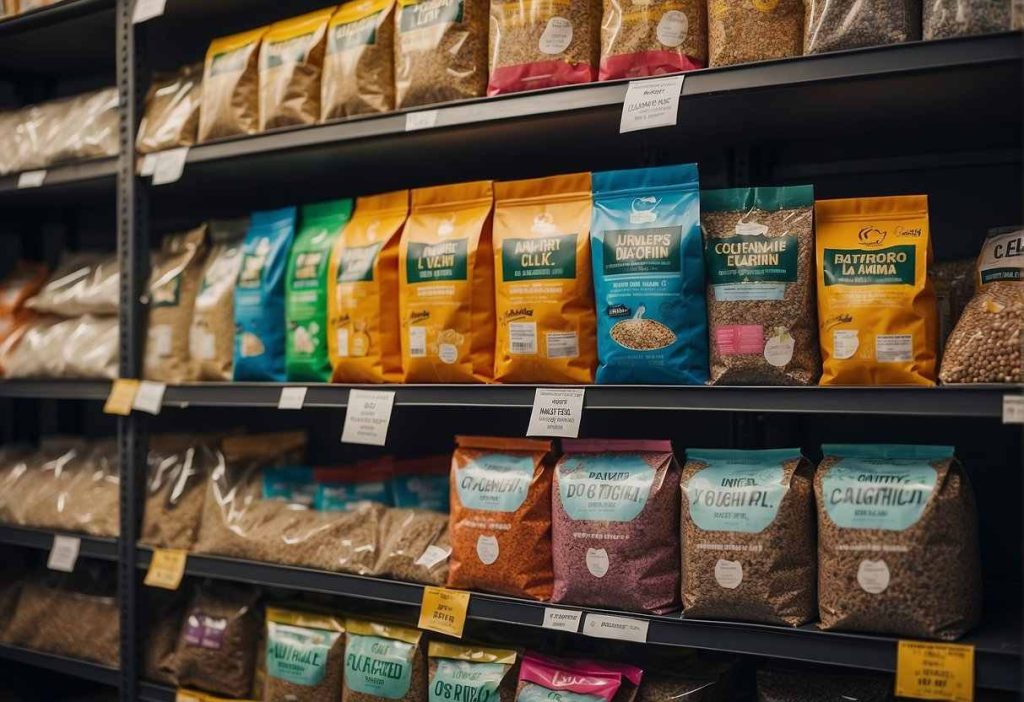
Guide for First-Time Cat Owners
Just get your first cat? Choosing the right litter can be crucial.
With options like clumping clay, which makes scooping a breeze, or the low-dust variety to prevent those sneezy episodes, your choice should be tailored to your cat’s needs and your cleaning preferences.
Managing Litter Boxes in Multi-Cat Households
Got a feline brigade? Here’s the scoop: Aim for one litter box per cat, plus one extra. Why? Cats cherish their personal space, even when doing their business.
Make sure boxes are scattered around your home to give options and prevent turf wars.
- Placement: Secluded, calm areas (think: low foot traffic)
- Litter Type: Multi-cat formulas for heavier use
- Cleaning: Regular scooping keeps the peace (and the nose)
Budget-Friendly Cat Litter Solutions
- Bulk Buying: Often cheaper in the long run
- Store Brands: Can be as effective as premium brands
- Choosing Non-Clumping: Generally more affordable than clumping
Remember, it’s not about being fancy; it’s about being practical. The right litter keeps your cat happy and your home smelling fresh.
And remember, when trying out new litters, introduce them slowly to avoid a kitty boycott!
Making the Switch to a New Cat Litter
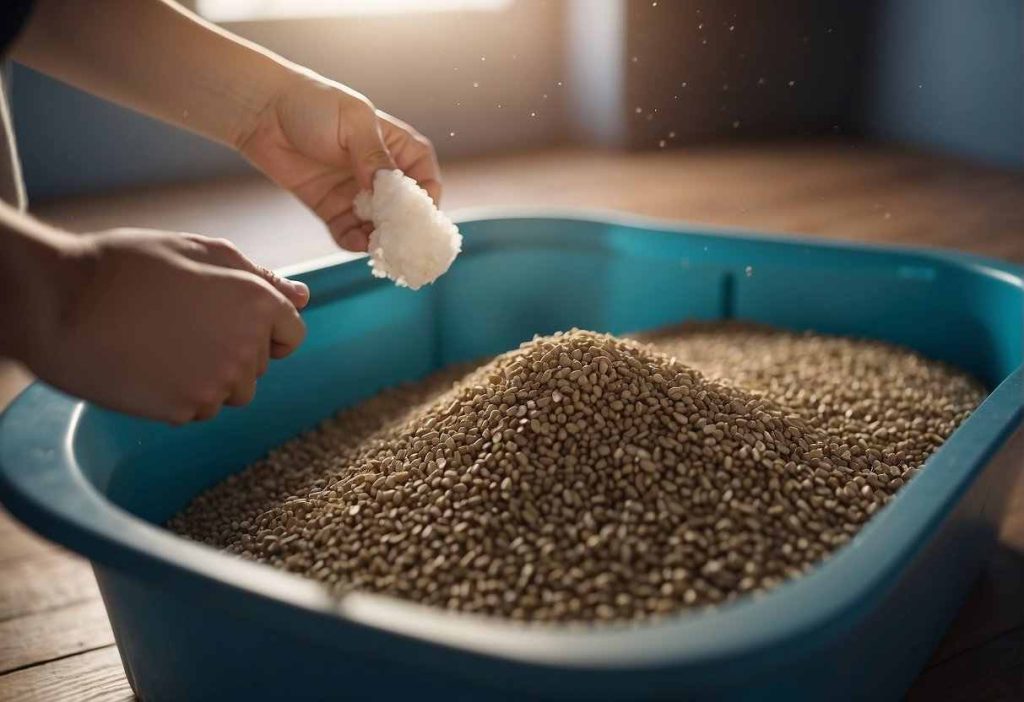
How to Introduce Your Cat to New Litter
Cats can be a tad finicky, so it’s crucial to bring in the new litter gradually. Here’s a quick step-by-step that works like a charm:
- Day 1-2: Mix about 1/3 of the new litter with 2/3 of the old one, placing the new litter at the bottom.
- Day 3-4: Shift to a half-and-half mix.
- Day 5-6: The box should now have 2/3 new litter and 1/3 old litter.
A little patience goes a long way! Keep this pace to avoid any hissy fits.
Monitoring Your Cat’s Adaptation
Keep a close eye on your cat’s behavior during this change. Are they using the litter box as usual or are they staging a peaceful protest on your laundry?
Signs of Acceptance or Rejection
A happy cat means a job well done! Here’s what you should look for:
- Acceptance: Your cat uses the new mix without hesitation.
- Rejection: A stubborn stance near the box might mean they’re giving it a thumbs down.
Remember, if Fluffy gives the new litter the cold shoulder, try slowing down the transition. Cats love routine, so sometimes they need just a tad more time to adjust.
Who knew switching cat litter could be such an adventure, right? With these tips, you’ll tackle it like a pro!
Quick Recap
Are you juggling with the choices for your feline friend’s litter? Let’s narrow down those options. Your cat’s litter can impact both of your lives, so it’s important to choose wisely!
- Clumping Clay: It’s a hit for its ease of scooping. When wet, it forms easy-to-remove lumps.
- Non-Clumping Clay: Typically more affordable, but it might mean more frequent cleaning sessions.
- Silica Gel Crystals: They’re super absorbent, which means a drier litter box and less frequent changes. However, they can be pricier.
Here’s a brief table to make your decision easier:
| Type | Clumping? | Odor Control | Maintenance | Cost |
| Clumping Clay | Yes | Good | Easy | $ |
| Non-Clumping Clay | No | Moderate | Moderate | $ |
| Silica Gel Crystals | N/A | Excellent | Low | $$ |
Maintenance Tip: With clumping clay, scoop daily to keep things fresh. Silica gel might need less frequent attention, but keep an eye on it.
Remember, your cat’s preference is king. Some cats might turn up their noses at certain textures or scents, so be prepared for a little trial and error.
With these tidbits of wisdom, may your litter quest lead to a happy home and a purring pet! 🐾
Frequently Asked Questions
Selecting the right cat litter for your fluffy companion can be a tail twister. Let’s scratch the surface with some important questions you might have!
Is clumping or non-clumping litter better for kittens?
For your little fuzzballs, non-clumping litter is often recommended.
It’s safer for kittens under four months as they tend to taste-test everything, and eating clumping litter can cause digestive blockages.
What should I consider when choosing a cat litter for odor control?
Odor control is key! Look for litters with activated charcoal or baking soda. A clumping litter also helps you remove waste easily, which keeps stink at bay.
Can you explain the pros and cons of natural vs. synthetic cat litter?
Sure, let’s dig in! Natural litters are biodegradable and often made from recycled materials, but they might not control odor as well as synthetic ones.
Synthetic litters usually clump better and control smell effectively, yet they’re not as environmentally friendly
How does silica cat litter compare to bentonite clay litter in terms of safety and effectiveness?
Silica gel litters are super absorbent and can control odor longer than clay.
But if Fluffy doesn’t fancy the crystal texture, bentonite clay is soft on paws and clumps well for easy scooping.
What factors should I keep in mind to find the healthiest cat litter for my feline friend?
Prioritize dust-free or low-dust options to protect your pal’s respiratory system.
Litters with natural ingredients or those without added fragrances and chemicals are often the healthiest picks.
What are some eco-friendly cat litter options, and how do they perform?
Eco-warriors, unite! Recycled paper, wood pellets, and corn-based litter are on your team.
They’re renewable and compostable, though some may not fight odors or clump as well as clay.
What’s the best way to transition my cat to a new type of litter?
Cats can be picky, so mix the new litter with the old one gradually over a week.
Start with a small amount of the new stuff and increase it each day.
This way, your kitty’s nose won’t turn up at the sudden change.
- The Ultimate Overview to Actual Cash Gambling Establishments - July 1, 2025


